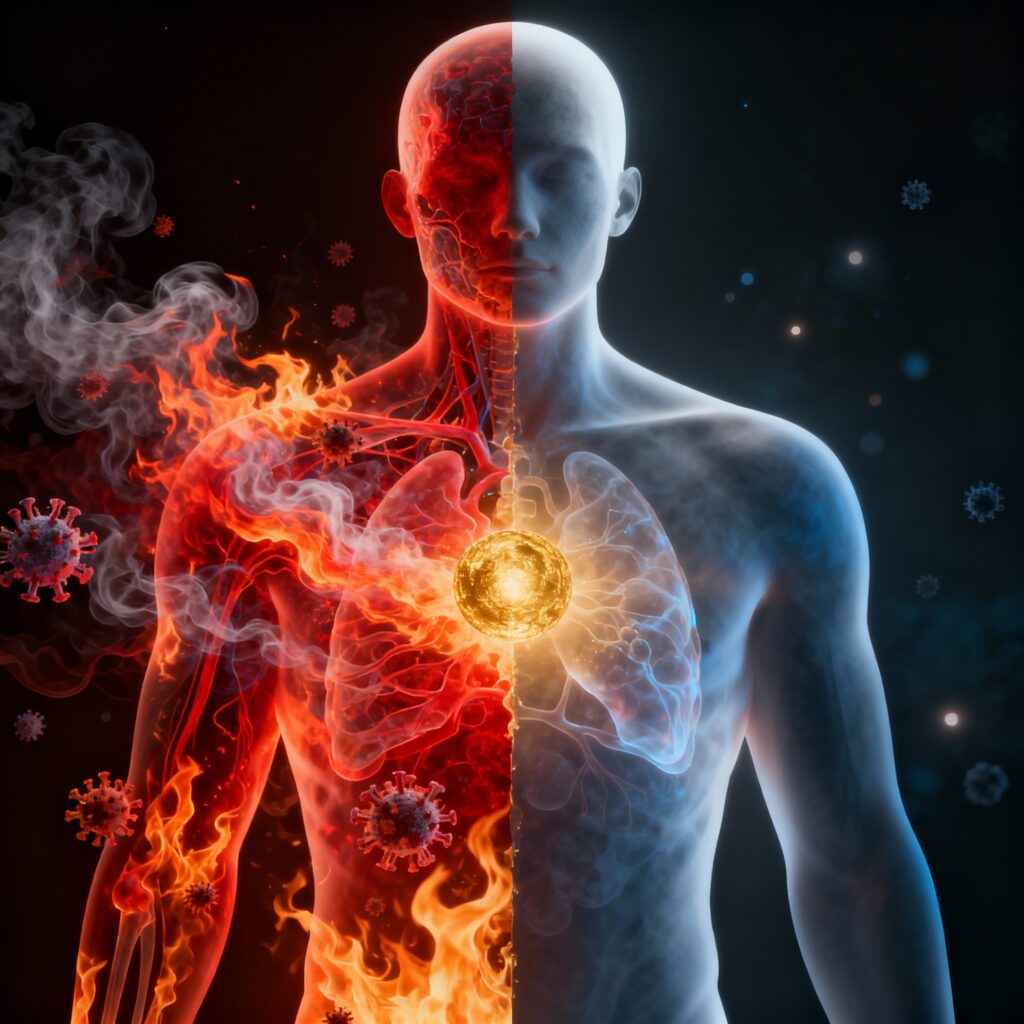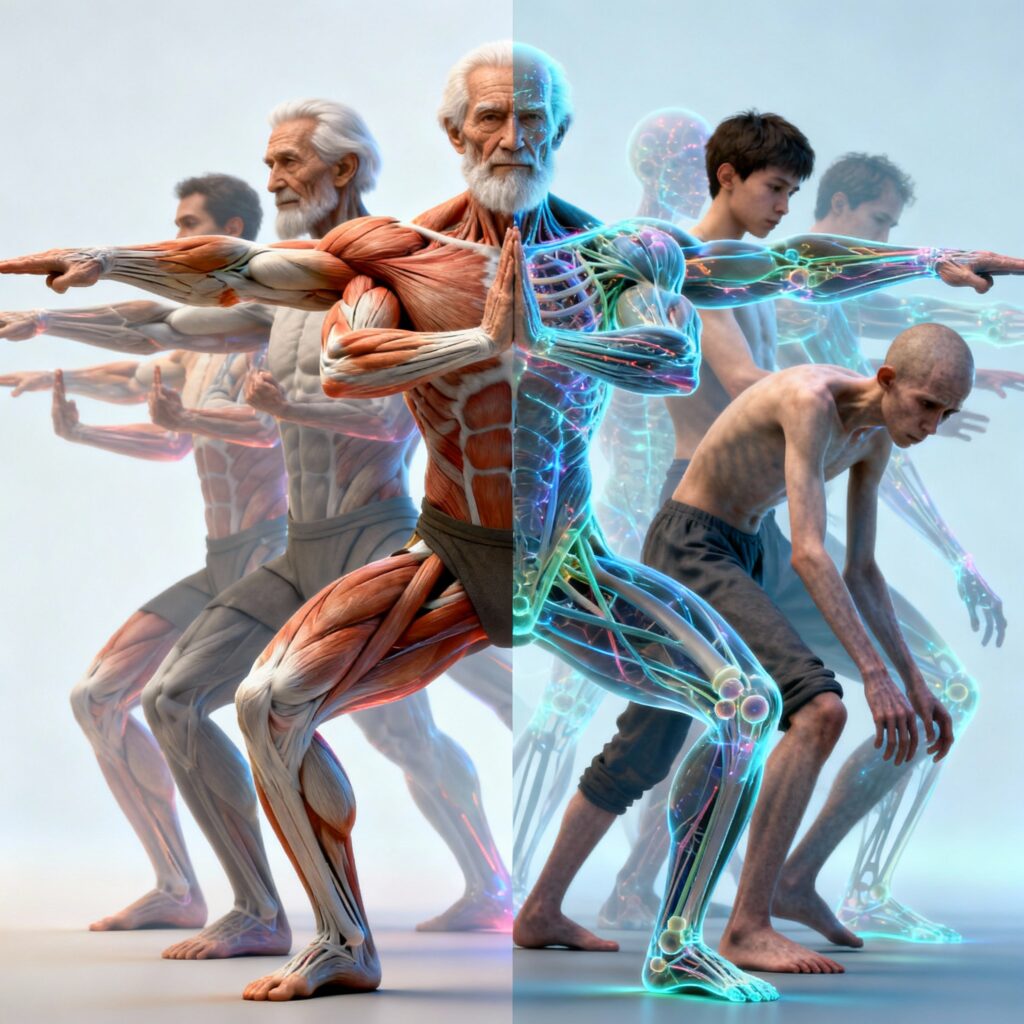Table of Contents
The Science Behind Why Your Immune System’s Balance—Not Your Age—Determines COVID-19 Outcomes
Published Research Reveals the Hidden Factor Protecting Against Severe Disease
Introduction: Age Is a Lie (Sort Of)
In 2021, in the very website, I explored, via number of posts, how severe viral pandemics like COVID-19 progress and what factors influence survival outcomes. The trajectory of the COVID-19 pandemic has exactly evolved in ways that were predicted in those posts—just like Flu, COVID-19 virus has become endemic in nature, and societies have adapted to coexist with it.
(You can read those article HERE, HERE and HERE).
Following the COVID-19 pandemic, age became a prominent factor in discussions about mortality risk with COVID-10. Based on what experts told and showed, we assumed COVID-19 severity followed a simple formula: older age = worse outcomes. While age matters, this explanation misses a critical truth that researchers at the University of Texas Health Science Center at San Antonio have now documented: a 30-year-old can develop severe COVID-19 while an 85-year-old walks away unscathed—and it has little to do with how many candles are on their birthday cake.
The culprit? A measure of immune system balance called immunologic resilience (IR)—the capacity to preserve immune competence while controlling inflammation when your body faces viral threats.
This discovery, published in the Journal of Allergy and Clinical Immunology, provides new insights into COVID-19 severity and suggests potential directions for predicting and treating severe disease. This is not a new paper. It was published in 2021. But I found this study particularly meaningful, as it confirms observations I’ve been publishing and prescribing since that start of COVID-19 pandemic.
(You can read those article HERE, HERE and HERE).
What Is Immunologic Resilience? The Immune System’s Most Important Balancing Act
Imagine your immune system as a tightrope walker. On one side, you need immunocompetence—the ability to recognize and destroy viruses. On the other side, you need controlled inflammation—enough immune response to fight infection without your own defenses destroying healthy tissue.
Immunologic resilience is the skill of walking that tightrope.
Most people think of immunity in black-and-white terms: stronger = better. The research presented in this paper shatters this myth. A powerful immune response without control creates what scientists call a “cytokine storm”—where inflammatory chemicals flood the bloodstream, damaging the lungs, heart, and other vital organs. This uncontrolled inflammation is a primary driver of severe COVID-19 and death.
Conversely, a weak immune response leaves the virus unchecked, allowing viral replication and tissue destruction.
The real power lies in the balance.

The CD4:CD8 Ratio—Your Immune System’s Report Card
The immune system reveals its health through a nuanced grading system, with four major categories and multiple subcategories reflecting subtle variations in CD4+ helper cells and CD8+ cytotoxic cells:
| Immune Health Grade | CD4+ Counts | CD8+ Levels | CD4:CD8 Ratio | Immune Profile |
|---|---|---|---|---|
| Grade I | Higher (~800) | Lower | ≥ 1.0 | Balanced immunity with dominant helper cell support |
| Grade IIa | Lower | Lowest | ≥ 1.0 | Moderately suppressed; CD4+ still dominant but declining |
| Grade IIb | Lower | Lowest | ≥ 1.0 | Further suppressed; both populations weakened |
| Grade IIc | Lower | Lowest | ≥ 1.0 | Most suppressed within Grade II spectrum |
| Grade III | Higher (~800) | Highest | < 1.0 | Highly activated; CD8+ cells now exceed CD4+ |
| Grade IVa | Lowest | Higher | < 1.0 | Dysregulated; initial CD4+ depletion with CD8+ dominance |
| Grade IVb | Lowest | Higher | < 1.0 | Progressive dysregulation; severe CD4+ deficiency |
| Grade IVc | Lowest | Higher | < 1.0 | Most severe dysregulation; critical CD4+ collapse |
Here’s how it works:
- CD8+ T cells: The “killers” that destroy virus-infected cells
- CD4+ T cells: The “helpers” that coordinate the immune response
The critical threshold lies at a CD4:CD8 ratio of 1.0. Above this threshold (Grades I and II), CD4+ helper cells maintain some control, though Grade II shows progressive immune suppression across its subcategories. Below this threshold (Grades III and IV), CD8+ cells dominate—but the implications differ dramatically. Grade III represents upgraded immune activation, while Grade IV reveals a troubling progression: as the subcategories advance from IVa through IVc, CD4+ helper cells collapse to their lowest levels while CD8+ cells remain elevated—a signature of severe immune dysregulation where the immune system loses its capacity for coordinated defense.
This granular classification captures not just immune strength, but immune coherence—the delicate balance that determines whether activation protects or destroys.
In short, in healthy individuals—defined as Immune Health Grade I (IHG-I)—CD4+ and CD8+ cells maintain a balanced ratio of approximately 1:1 or a little more. When healthy, robust immune systems encounter SARS-CoV-2, they preserve this equilibrium. But in people with pre-existing immune dysfunction or those who develop it during COVID-19(IHG-II, IHG-III, IHG-IV), this balance deteriorates. This disequilibrium correlates directly with disease severity, hospitalization, mechanical ventilation, and death.
The CD4:CD8 T-cell ratio’s utility in predicting mortality—a premise explored in this website in prior posts—now receives empirical validation from independent research. The researchers extended this line of thinking considerably, moving from a simple ratio into a more sophisticated taxonomy of immune states. This granular approach reveals what broader observations had only hinted at: that immune dysregulation itself exists in degrees, each with distinct clinical implications.
The Stunning Results: How Immunologic Resilience Predicts Survival
Researchers followed 522 COVID-19 patients at San Antonio’s VA hospital, measuring their immune health grade at admission and tracking outcomes.
Thirty days into illness, survival rates diverged starkly across immune grades. Patients with Grade I immunity—the balanced state—experienced the lowest mortality at just 1%. Those with Grade II immunity fared worse at 11%, their suppressed defenses offering little protection. Most troubling were Grade IV patients, whose dysregulated immune systems claimed 16% mortality within the same timeframe. This threefold difference between Grade I and Grade IV was statistically significant, revealing how profoundly immune balance determines survival.
Adjusted for age and sex, patients with IHG Grade -I had 88% lower mortality compared to other groups.
Let that sink in. A 30-year-old with IHG-IV (poor resilience) faced higher hospitalization and mortality risk than a 70-year-old with IHG-I (good resilience).
Patients preserving IHG-I also experienced:
- Rapid viral clearance: Nasopharyngeal SARS-CoV-2 burden dropped 87% faster compared to IHG-IV patients
- Lower inflammation: Plasma IL-6 (a critical inflammatory marker) remained controlled
- Reduced hospitalization: 88% lower odds of requiring hospitalization
- Faster discharge: 2x faster recovery rate
The Sex Bias: Why Females Are More Likely to Preserve Immunologic Resilience
One of the paper’s most striking findings involves sex differences.
Across all age groups:
- Females were significantly more likely to present with IHG-I (35% vs. 20% in males)
- Males showed greater proclivity to develop IHG-II and IHG-IV (immunologic decline)
Why? Researchers point to several factors:
- Biological sex differences in immune response: Females typically mount more robust adaptive immune responses to viral infections, partly due to X-chromosome-linked immune genes
- Hormonal factors: Estrogen enhances certain immune responses; testosterone can suppress them
- Sex-based differences in inflammation control: Females tend to mount more controlled inflammatory responses
This isn’t hypothetical. In the Framingham Heart Study—which tracked thousands of people for nearly a decade—the same immunologic resilience metrics that predicted COVID-19 survival also predicted 9-year survival in the general population, with particularly strong protective effects in women.

Beyond COVID-19: Immunologic Resilience Predicts Longevity and Resistance to Multiple Infections
What makes this research revolutionary isn’t just its COVID-19 findings. Researchers examined whether the same IR metrics predicted outcomes in non-COVID-19 populations:
HIV Infection
In people living with HIV, preservation of IHG-I was the strongest predictor of resistance to AIDS progression. Even before modern antiretroviral therapy, some individuals naturally resisted AIDS development (called “long-term nonprogressors”). These individuals disproportionately maintained IHG-I.
Influenza Infection
In both natural influenza infection and experimental challenge studies, patients maintaining IHG-I showed less severe disease, even among younger, otherwise-healthy individuals.
General Population Longevity
In the Framingham Heart Study of 2,306 participants tracked over 9 years:
- Individuals maintaining IHG-I had significantly lower mortality hazards
- This protective effect remained even after controlling for age, sex, and comorbidities
- The benefit was stronger in females than males
Conclusion: Immunologic resilience isn’t just a COVID-19 survival factor—it’s a fundamental marker of healthy aging and resistance to infectious disease across the lifespan.
The Molecular Basis: Gene Signatures Separating Survivors from Non-Survivors
Researchers didn’t stop at measuring cell counts. They sequenced RNA from 48 COVID-19 patients’ blood and nasal cells to identify which genes predicted survival.
They discovered 28 beneficial genes and 51 distinct gene expression patterns that clearly separated survivors from non-survivors. While I don’t intend to go in details if those gene expressions and their corresponding functions, but they indicate a pattern. And that pattern is unmistakable: Survivors maintain robust immune response and inflammatory control. Non-survivors show either inadequate immune recognition or excessive, uncontrolled inflammation.
Over-reaction by immune system is the single most important factor that led to mortality during COVID-19 pandemic. That’s why immune suppressing drugs became life savers. Anti-virals were literally ineffective in saving lives significantly.
Virus was not the killer. Our own immune system killed us.
The Immunologic Resilience Phenotypes: Three Types of COVID-19 Patients
Based on these findings, researchers identified three distinct IR-dependent COVID-19 phenotypes:
Phenotype 1: The Resilience Preservers (Best Prognosis)
- Pre-COVID IR status: High immunocompetence, low inflammation
- Response to SARS-CoV-2: Resist infection-induced immunologic decline
- Sex bias: Predominantly female
- Outcome: Mild or asymptomatic COVID-19; 88% lower mortality
- Real-world example: A 60-year-old female with preserved IHG-I who develops mild COVID-19 despite high viral exposure
Phenotype 2: The Intermediate Responders (Moderate Prognosis)
- Pre-COVID IR status: High immunocompetence, low inflammation
- Response to SARS-CoV-2: Susceptible to infection-induced immunologic decline
- Sex bias: More common in males
- Outcome: Moderate COVID-19; intermediate mortality
- Real-world example: A 45-year-old male who seemed healthy but deteriorated during COVID-19 due to loss of immunologic balance
Phenotype 3: The Vulnerable (Worst Prognosis)
- Pre-COVID IR status: Pre-existing low immunocompetence, high inflammation
- Response to SARS-CoV-2: Susceptible to additional infection-induced decline
- Sex bias: Predominantly male
- Outcome: Severe COVID-19; 8-9x higher mortality than Phenotype 1
- Real-world example: An older adult or someone with chronic disease who entered COVID-19 with already-compromised immunity
Does CMV Serostatus Matters?
Researchers tested whether cytomegalovirus (CMV) serostatus—often used as a marker of immune aging—explained their findings. CMV is a herpes virus that most people carry dormant, and CMV seropositivity has been associated with immune aging.
The result? While CMV seropositivity correlated with older age and worse outcomes, CMV status did NOT independently predict COVID-19 outcomes. The IR metrics remained independently predictive even after controlling for CMV status.
This means immunologic resilience is a distinct phenomenon from immune aging—more fundamental and more predictive than previously recognized aging markers.
However, in my view, CMV might contribute towards tilting Phenotype 2 patients to become Phenotype 3. CMV accelerates aging of our immune system. This is my hypothesis- I will wait for future research to confirm or deny this hypothesis.
Viral Clearance: Why Your Immune Balance Controls the Virus Directly
It is often assumed that magnitude of immune response would correlate with efficiency of viral clearance. But this is NOT true. The researchers who published this paper showed that patients preserving immunologic balance cleared the virus faster.
- IHG-I patients: Achieved rapid nasopharyngeal SARS-CoV-2 clearance
- IHG-IV patients: Showed 87% slower viral clearance (rate ratio 0.13)
Why? The nasal transcriptome revealed that gene expressions associated with:
- Robust antiviral responses (interferon pathways, viral pattern recognition)
- Epithelial barrier integrity (tight junctions preventing viral dissemination)
- Controlled but effective inflammation
…clustered together in patients with rapid viral clearance.
Conversely, gene expressions associated with excessive inflammation and loss of epithelial barriers correlated with:
- Higher viral burden
- Worse outcomes
- Mechanical ventilation requirements
- Death
The message is now clear: A balanced and mature immune system’s is more powerful in eliminating virus quickly as compared to a hyper-aggressive immune system.
This observation may initially seem counterintuitive, yet it reveals something far more profound: every cell, every tissue holds a piece of our defense—a secret the body guards carefully. When immune cells turn hyperaggressive, they don’t merely fail to protect; they become architects of their own undoing, dismantling the very barriers they were summoned to preserve. Consider this paradox: a fort stands fortified, its walls impenetrable to any external enemy. But what happens when the defenders themselves, wielding weapons of devastating power, turn those weapons inward? Their bombs obliterate the enemy, yes—but the walls crumble too. And in the ruins of those destroyed fortifications, something sinister unfolds: the enemy finds shelter in the rubble, slipping effortlessly through the fractured defenses.
This mirrors something far more troubling about severe COVID-19, that we have earlier discussed at multiple occasions. These hyperaggressive immune soldiers, armed with their most potent weapons, didn’t merely breach their own walls—they destroyed the very people they fought to save. The mechanism remains haunting: an immune system locked in overdrive, unable to distinguish ally from enemy, becomes the silent architect of its host’s decline. Emerging evidence suggests this dysregulated response—this self-inflicted wound—may have been among the most consequential factors in COVID-19 mortality, a puzzle that rewrites what we thought we knew about survival and defense.
Immune Health Grade (IHG) Predicts Death
Perhaps most importantly, in this paper, researchers demonstrated that IHG status provided probability of death due to COVID-19
When they modeled hospitalization risk:
- A 30-year-old with IHG-IIc (severe imbalance) had an 80% probability of hospitalization
- A 95-year-old with IHG-I (preserved balance) had an 81% probability remaining hospitalized-free
Put another way: Your immune balance matters more than whether you’re 30 or 95.
The data showed:
- The strength of IHG predictions equaled or exceeded age in predicting outcomes
- IHG predictions were independent of age, sex, BMI, and CMV status
- IHG status was more granular, offering uniform metrics across all age groups (unlike raw lymphocyte counts, which vary dramatically by age)
How to use IHG?
The Immune Health Grade transcends COVID-19. Emerging evidence suggests it may serve as a universal marker of mortality risk across diverse pathologic states—a window into the body’s fundamental capacity to defend itself without self-destruction.
A Simple Yet Overlooked Strategy
The CD4:CD8 ratio holds a curious paradox: it is simultaneously one of medicine’s most accessible and most overlooked windows into immune health. For decades, this measurement has quietly existed in laboratories worldwide—simple, inexpensive, and remarkably accurate—yet it remains largely dormant in routine clinical practice. Despite its accessibility since the HIV-AIDS era, this ratio has never fully emerged from the shadows of specialized medicine. A more deliberate approach might suggest establishing a baseline CD4:CD8 measurement early in life, then tracking its evolution at regular intervals. Over time, such surveillance could reveal patterns invisible in isolated moments—the subtle shifts that precede dysregulation, the markers of immune coherence or its dissolution.
What these IHG grades reveal: Grade I indicates immune equilibrium—a signature of health. Those falling outside this grade face an unsettling question: what has disrupted their immune balance? The answer demands investigation. A physician’s guidance becomes essential to identify underlying causes. Yet if investigation yields nothing, the path forward becomes clear: deliberate intervention through regular exercise, thoughtful nutrition, restorative sleep, and other evidence-based health practices may gradually restore balance.
From Prediction to Prevention
Risk stratification using IHG grades could reshape clinical decision-making: identifying which patients face elevated hospitalization and intensive care needs before crisis strikes. More provocatively, early intervention in those beginning to lose immunologic coherence—before dysregulation deepens—might alter trajectories that currently seem inevitable. The question emerging is not whether we can measure immune health, but why we’ve waited so long to make it routine.
Vaccine Implications: Why Immunologic Resilience Matters for Vaccination Durability
The authors note a crucial implication: vaccine durability may wane faster in people with inferior immunologic resilience.
If your baseline immune system can’t maintain balance during an infection, it may struggle to maintain the balance required to sustain vaccine-induced immunity over time. This suggests:
- Different vaccination schedules for people with pre-existing IR deficits
- Combination immunotherapies to preserve IR while vaccinating
- Periodic IR monitoring in high-risk populations to determine booster timing
The Bigger Picture: Immunologic Resilience as a Biomarker of Healthy Aging
This research points toward a revolutionary shift in medicine: moving from chronologic age to immune age.
Instead of assuming a 75-year-old will do poorly with COVID-19 (or influenza or HIV), clinicians could measure immunologic resilience and say: “This 75-year-old has the immune profile of a healthy 50-year-old—different treatment approach.”
Conversely: “This 40-year-old has the immune profile of a frail 80-year-old—aggressive intervention needed.”
This framework aligns with emerging concepts like “immune age” (measured by specific gene signatures) and inflammaging (chronic, low-grade inflammation with aging). Immunologic resilience captures something fundamental about healthy aging: the capacity to mount robust responses without losing control.

Conclusion: A New Era of Precision Medicine In Critical Care
The discovery of immunologic resilience fundamentally reshapes our understanding of COVID-19 severity and, more broadly, outcomes of critical health events across the lifespan.
Key takeaways:
- Age is not destiny: Your immune system’s balance predicts survival better than chronologic age
- Males face higher risk: A male-biased proclivity to degrade immunologic resilience explains sex differences in COVID-19 severity
- Prevention is precision: Measuring IR at admission could enable early interventions targeting immunologic collapse
- Longevity is interconnected: The same metrics predicting COVID-19 survival also predict long-term survival in the general population
The authors of today’s paper that we discussed write: “Preservation of immunocompetence with controlled inflammation during antigenic challenges is a hallmark of IR and associates with longevity and AIDS resistance.“
This isn’t just about COVID-19. It’s about redefining how we understand health, aging, and the capacity to survive infectious disease across the human lifespan. As we face emerging pathogens—whether new coronaviruses, influenza variants, or unknown future threats—understanding and measuring immunologic resilience may determine who thrives and who struggles.
The future of critical care medicine is personalized, precise, and rooted in immunologic resilience.
References
Lee, G. C., Restrepo, M. I., Harper, N., et al. (2021). Immunologic resilience and COVID-19 survival advantage. Journal of Allergy and Clinical Immunology, 148(5), 1176-1191.
Peng, Y., et al. (2022). Individuals with higher CD4/CD8 ratio exhibit increased risk of severe COVID-19. Frontiers in Medicine, 9, 924267.
Nature Communications. (2023). Immune resilience despite inflammatory stress promotes longevity and favorable health outcomes.
University of Texas Health Science Center at San Antonio. (2021). Immunologic resilience: A new metric to accurately gauge COVID-19’s path.
About the Research: This essay synthesizes findings from peer-reviewed research published in the Journal of Allergy and Clinical Immunology and validated across multiple cohorts including the Framingham Heart Study, SardiNIA aging cohort, HIV natural history studies, and influenza challenge studies. All claims are grounded in published data and statistical analysis.





